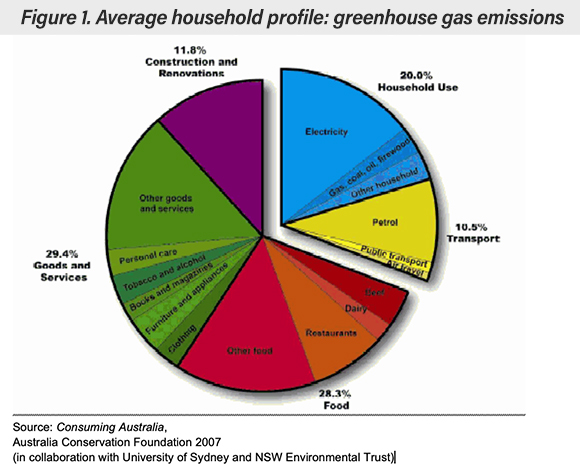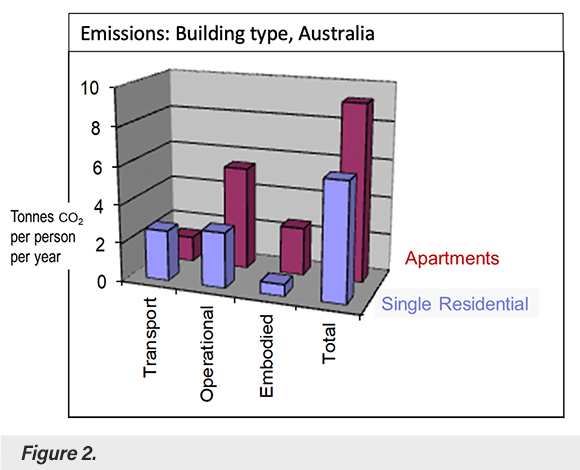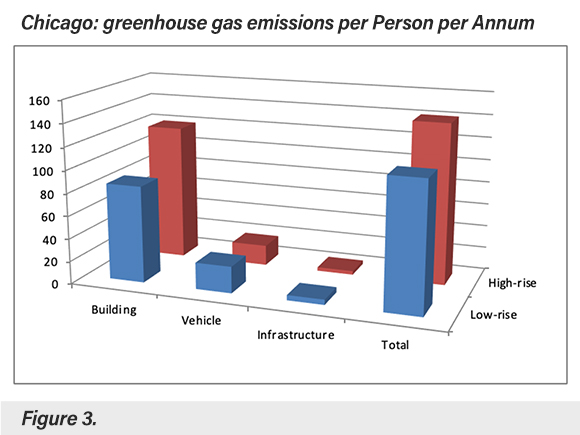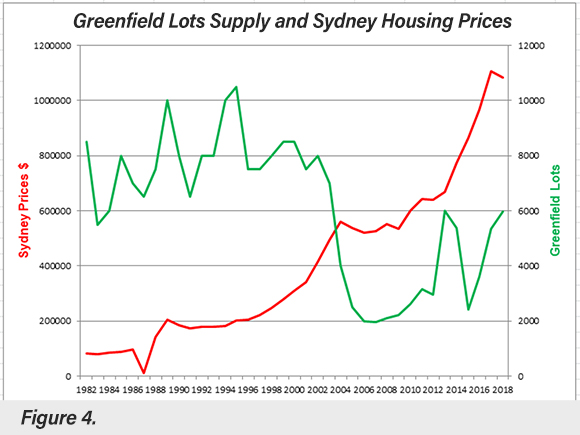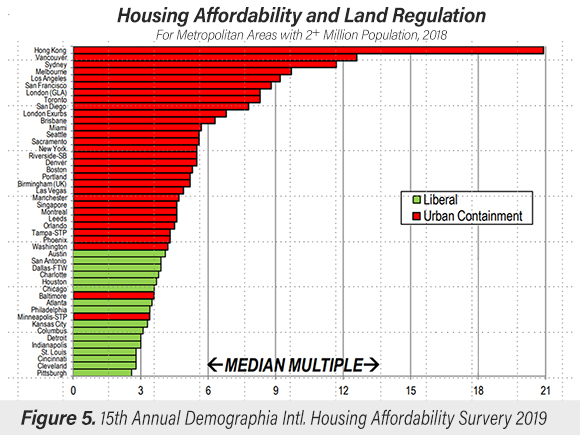
High-density planning policies have become fashionable and Sydney planners are among the most enthusiastic adopters. New South Wales Government authorities claim that high density policies result in a reduction of greenhouse gas emissions (gge), provide improved housing affordability and result in reduced traffic congestion. No evidence has been provided to justify these assertions. Such claims need to be investigated as well as density’s detrimental effect on amenity and quality of life should also be investigated.
Sustainability
A belief pervades the planning profession, academia and the general public that environmental benefits result from high density living. Conventional planning wisdom intuitively maintains that this results in reduced greenhouse gas emissions, notably as a result of reduced car travel which seems self-evident. However research shows this not to be the case. It transpires there are many factors affecting car travel which can have an equal or greater influence on travel outcomes.
The Australian Conservation Foundation has conducted an important study by comprehensively calculating greenhouse gas emissions for the average person living in each post code (zip code). The study, which was featured on its website, used input-output tables combined with regional expenditure. These emissions relate to direct consumption by households for requirements such as fuel and power as well as indirect requirements through the consumption of goods and services. The production of goods and services such as food, transport, dwelling construction and personal care result in greenhouse gas emissions and when considering the effect of density it is more meaningful to allocate these emissions at the point of consumption rather than at the point of production. For example when determining emissions a person is responsible for, emissions resulting from the production of electricity should be allocated to the post code where the electricity is consumed rather than to where it is initially generated.
The typical household profile is:
Factors relating to the type of dwelling are displayed in Figure 2.
Sources: https://www.sos.org.au/newgeo1.html
This data shows that per person emissions in apartments in Australia are more than in single residential dwellings. Transport is only a small proportion of people’s emissions. Operational energy is considerable in high-rise powering lifts, and lighting and air-conditioning in the common areas. Embodied energy, – the energy of construction amortised over the life of the building – is much higher from high-rise, due to steel and concrete components and method of construction.
A study in Chicago provides a similar picture (Figure 3).
Sources: https://www.sos.org.au/newgeo2.html
For total emissions there are many additional factors to take into account. Wealth is an important factor. Wealthy people spend more on goods and services. The number of people per household is significant – single residential dwellings tend to house more people, so reducing per person emissions.
The net results of this Australian Conservation Foundation study show that in the high density core areas of Australian capital cities with populations of more than one million (Sydney, Melbourne, Brisbane, Adelaide and Perth) the annual average emissions of greenhouse gas is 27.9 tonnes per capita while in the low density outer areas this figure is 17.5 (which is 38 percent less than in core areas). This is contrary to fashionable opinion that high density is more sustainable than low density. The New South Wales Government’s claim that high density policies result in a reduction of greenhouse gas emissions cannot and has not been substantiated.
In addition to this finding it should be borne in mind that high density provides less roof area per person for the collection of solar energy and rainwater.
The effects of living in high-density on human health should be considered. High density considerably increases the incidence of mental illness. An important letter in the journal Nature discusses urban neural social stress. It states that the incidence of the major brain disorder schizophrenia is approximately doubled in higher density cities. There are other documented negative health effects, such as those resulting from an absence of green space. The possible result of increased density on the spread of epidemics such as that of the recent Wuhan Corona virus outbreak should be borne in mind. Analysis of the SARS pandemic of 2002 found that population density was an explanatory factor for the spread of that epidemic which infected 8,096 people and killed 774.
Housing Affordability
The New South Wales Government maintains that high-density policies reduce housing cost. This is not supported by the evidence. High-density planning policies have severely impacted housing affordability.
At one time nearly all Australians could afford to own their own home. However, in about the middle of the 1990’s, the NSW government began to introduce policies aimed at increasing density. In the face of a rising population, this strategy was put into effect by restricting land release, coupled with demands on local governments to increase density in their areas. The green line on the Figure 4 shows that peripheral land release, previously increasing to 10,000 lots per year, declined to less than 2,000 as prices soared.
Sources: https://www.sos.org.au/newgeo5.html
Indeed since the densification strategy was adopted, the land component in the cost of a dwelling swelled from 30% to 70% or even more. Home ownership among the poorest 20% of Sydney households, previously stable, has fallen from the 63% to 23%. The number of years of household income needed to purchase a house increased from 3 years to 12 years.
Figure 5 depicts the median number of years of household income required to purchase a dwelling of median price, termed “Median Multiple”. It can be seen that housing in Sydney has become among the most expensive in world for which data can be obtained, third after Hong Kong and Vancouver.
Generally, the jurisdictions featuring urban containment policies (high density policies) tend to be the most expensive. It is apparent that cities in the southern United States tend to be the most affordable.
Congestion
The New South Wales Government has maintained that high-density policies will ameliorate traffic congestion on the basis that more use will be made of public transport. But since the introduction of high density policies, congestion in Sydney has become noticeably worse and public dissatisfaction has been steadily increasing.
The Government has established a body called the Greater Sydney Commission which has become the means whereby higher densities are imposed onto communities. This is accomplished by local councils being required to obtain written advice from this Commission with regard to their planning policies. The Commission justifies this strategy by claiming that this will enable the creation of a “Metropolis of Three Cities” in which no one will be more than thirty minutes away from their jobs and public services.
This image of such a metropolis is based on a number of misconceptions. One is that most of the jobs in Sydney currently are in the CBD and these can be distributed among three cities by matching high density dwellings with workplaces. But a study reveals only 14.5% of jobs are currently in the CBD, the rest are already spread throughout the city. This makes it unlikely the Commission’s “Three Cities” plan will change the current overall jobs/dwelling relationship in any significant way.
Fragmentation of a large labour market by aligning jobs with residential clusters is not feasible. Peter Hall describes a system of clustering employment and high density dwellings at transport nodes in Stockholm that proved a failure. Most of the people who lived in the clusters worked elsewhere and most of those who worked in the clusters came from elsewhere. Travel was not reduced.
With regard to the Commission’s postulated “Thirty Minute City” and contrary to Government claims, investigation of parameters relating to traffic reveal that traffic conditions and accessibility do not improve as density is increased. Table 1 shows that as density increases the level of congestion also tends to increase. The comparison of Sydney with low density United States cities of similar size in the table below also indicates that one-way commute times (where available) and the number of jobs accessible from home within 30 minutes by automobile are generally better in lower densities.
| Population, Traffic and Accessibility | ||||||
|---|---|---|---|---|---|---|
| City | COUNTRY | POPULATION1 | DENSITY1 | CONGESTION LEVEL2 | ONE-WAY COMMUTE min3 |
30-MINUTE AUTO ACCESSIBILITY4 |
| Phoenix | United States | 4,365,000 | 1,200 | 17% | 25 | 803,505 |
| Dallas—Fort Worth | United States | 6,600,000 | 1,100 | 18% | 26 | 993,369 |
| Houston | United States | 6,285,000 | 1,100 | 25% | 28 | 829,147 |
| Melbourne | Australia | 4,305,000 | 1,600 | 29% | 34 | 380,754 |
| Sydney | Australia | 4,690,000 | 2,000 | 34% | 34 | 342,579 |
| New York | United States | 21,575,000 | 1,700 | 36% | 34 | 1,241,973 |
| Los Angeles | United States | 15,620,000 | 2,300 | 41% | 29 | 1,282,378 |
Sources: https://www.sos.org.au/newgeo8.html
High-density imposed by the Greater Sydney Commission cannot be claimed as a solution to congestion problems. Government assertions that high-density policies will ameliorate traffic congestion are not supported.
Conclusion
No evidence on which to base any justification for high density policies has been provided by the New South Wales Government. These policies seem to be ideologically driven, based on the faulty academic and planning assumption that they are superior from the environmental point of view. However the problems resulting from these policies - exacerbated housing unaffordability, congestion and greenhouse gas emissions - are detrimentally affecting the quality of life of Sydney residents. A radical change in planning policies for Sydney is called for.
The policies of cities featuring superior housing affordability, accessibility and economic progress such as Houston and Dallas-Fort Worth should be investigated. There is no reason why the strategic direction of Australian planning policies cannot be changed. The country is not short of land. Only 0.2% is urbanised. What is needed is a change in the mindset of politicians and the public service.
(Dr) Tony Recsei has a background in chemistry and is an environmental consultant. Since retiring he has taken an interest in community affairs and is president of the Save Our Suburbs community group which opposes over-development forced onto communities by the New South Wales State Government.
Photo: Meganesia via Wikimedia under CC 4.0 License.
